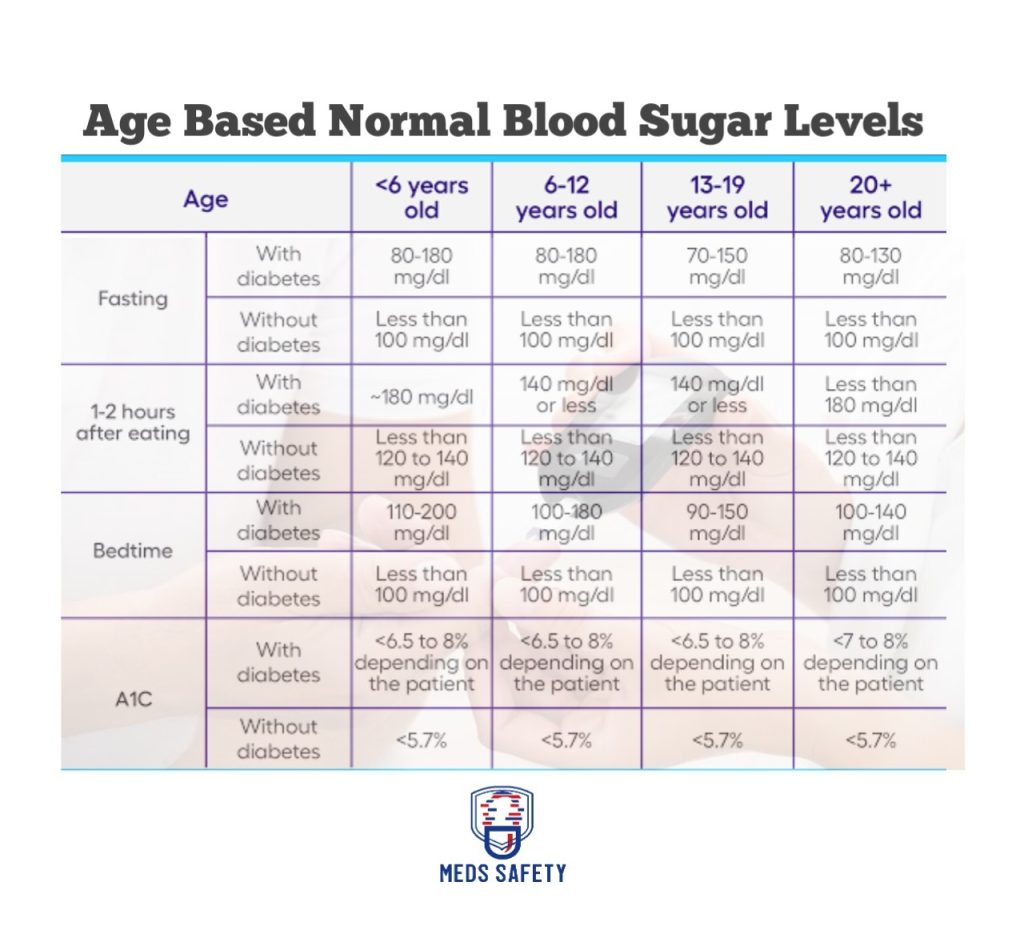Normal Blood Sugar Levels by Age

Blood sugar levels are a crucial aspect of our health and well-being. They play a significant role in maintaining energy levels, cognitive function, and overall physical health. However, what is considered normal blood sugar levels can vary depending on a person’s age.
In this guide, we will explore normal blood sugar levels by age, offering insights into how they change throughout one’s life and the implications for health.
Blood Sugar Levels
Before delving into the specifics of normal blood sugar levels at different ages, it’s essential to grasp the basics of blood sugar, also known as glucose. Glucose is the primary source of energy for our bodies, and maintaining an optimal level is crucial for overall health. Blood sugar levels are influenced by various factors, including diet, physical activity, and the body’s natural regulatory mechanisms.
Blood sugar levels are typically measured in milligrams of glucose per deciliter of blood (mg/dL). The levels can fluctuate throughout the day, with the lowest usually occurring in the morning after an overnight fast and peaking after meals.

Normal Blood Sugar Levels by Age
Based on The American Diabetes Association template normal blood sugar levels are as follows:
1. Infants and Children: Infants and young children generally have slightly higher blood sugar levels than adults. Normal fasting blood sugar levels for infants and children typically range from 70 to 100 mg/dL. However, these levels may vary slightly depending on factors like age, weight, and individual physiology.
2. Adolescents: As children transition into adolescence, their blood sugar levels start to approach adult levels. A fasting blood sugar level of 70 to 100 mg/dL is considered normal for adolescents. Puberty and growth spurts can affect these levels.
3. Adults: For adults, the normal range of fasting blood sugar levels is between 70 and 100 mg/dL. Blood sugar levels can vary depending on individual factors, such as diet, physical activity, and genetics.
4. Older Adults: As people age, there is a tendency for blood sugar levels to become slightly higher. Normal fasting blood sugar levels for older adults (typically 65 and above) may range from 80 to 120 mg/dL. However, maintaining levels below 100 mg/dL is still ideal for overall health.
5. Pregnant Women: During pregnancy, blood sugar levels can fluctuate due to hormonal changes. It is essential for pregnant women to maintain tight control over their blood sugar levels to avoid complications. Fasting levels below 95 mg/dL are generally recommended during pregnancy, although individual recommendations may vary.
Blood Sugar Levels After Eating (Postprandial)
In addition to fasting blood sugar levels, postprandial (after eating) blood sugar levels are crucial indicators of glucose control. For most individuals, blood sugar levels should typically remain below 140 mg/dL two hours after a meal. This value can vary depending on age, individual health, and the composition of the meal.
Implications of Abnormal Blood Sugar Levels
Abnormal blood sugar levels can have various health implications depending on whether they are consistently too high (hyperglycemia) or too low (hypoglycemia).
1. Hyperglycemia: Elevated blood sugar levels over an extended period can lead to type 2 diabetes, a condition characterized by insulin resistance and inadequate insulin production. Complications of uncontrolled hyperglycemia can include cardiovascular disease, nerve damage, kidney problems, vision issues, and more.
2. Hypoglycemia: Low blood sugar levels, especially if severe or recurrent, can result in hypoglycemia. Symptoms may include confusion, dizziness, weakness, and, in extreme cases, loss of consciousness. Prolonged untreated hypoglycemia can be life-threatening.
Factors Affecting Blood Sugar Levels
Blood sugar levels are dynamic and subject to a wide range of influences. Understanding these factors can help individuals make informed choices to manage their blood sugar effectively. Here are the key factors affecting blood sugar levels in greater detail:
1. Diet:
• Carbohydrates: Carbohydrate-rich foods like bread, rice, pasta, and sugary snacks can cause a significant rise in blood sugar levels. The body breaks down carbohydrates into glucose, leading to an increase in blood sugar. The type of carbohydrates matters, with complex carbohydrates from whole grains having a slower and more steady effect compared to simple sugars.
• Protein: Protein-containing foods can also have a modest impact on blood sugar levels, though it is generally lower than that of carbohydrates.
• Fiber: High-fiber foods like fruits, vegetables, and whole grains can help stabilize blood sugar levels. Fiber slows down the digestion and absorption of carbohydrates, preventing rapid spikes.
• Glycemic Index: The glycemic index (GI) rates carbohydrates based on their impact on blood sugar levels. Foods with a high GI cause a rapid increase, while low-GI foods lead to a slower, more gradual increase.
• Meal Timing: The timing of meals is essential. Skipping meals or having irregular eating patterns can result in erratic blood sugar levels. Consistent meal timing can help maintain stability.
2. Physical Activity:
• Exercise: Regular physical activity can enhance insulin sensitivity, allowing cells to use glucose more efficiently. It also encourages the muscles to take up glucose from the bloodstream, lowering blood sugar levels.
• Timing: The timing of exercise can affect blood sugar levels. For some people, engaging in physical activity after a meal can help control post-meal spikes in blood sugar.
• Intensity: More intense exercise may lead to a temporary increase in blood sugar levels during and immediately after the activity, but it usually decreases in the hours following exercise.
3. Medications:
• Insulin: Insulin is a hormone that lowers blood sugar levels by facilitating the uptake of glucose by cells. People with diabetes may require insulin therapy to maintain their blood sugar within a healthy range.
• Oral Medications: Some oral medications prescribed for diabetes help the body use insulin more effectively or reduce the release of glucose from the liver.
• Corticosteroids: Medications like corticosteroids, often used to treat inflammatory conditions, can elevate blood sugar levels.
4. Hormones:
• Puberty: Hormonal changes during puberty can lead to increased insulin resistance and may cause fluctuations in blood sugar levels.
• Pregnancy: Pregnancy hormones can affect insulin sensitivity. Gestational diabetes, a temporary form of diabetes during pregnancy, can develop in some women.
• Menopause: Hormonal changes during menopause can also influence insulin sensitivity and blood sugar regulation.
5. Stress:
• Stress Hormones: The body’s response to stress, often referred to as the “fight or flight” response, involves the release of stress hormones like cortisol and epinephrine. These hormones can increase blood sugar levels, as they prepare the body for action.
• Emotional Stress: Emotional stress can also lead to overeating or poor dietary choices, indirectly affecting blood sugar levels.
6. Illness:
• Infections: Infections and fever can lead to elevated blood sugar levels as the body’s immune response requires extra energy.
• Dehydration: Dehydration can lead to concentrated blood sugar levels, as there is less fluid in the bloodstream.
• Medications for Illness: Some over-the-counter medications, such as cough syrups, can contain sugar or alcohol, which may affect blood sugar levels.
7. Genetics:
• Family History: A family history of diabetes or other metabolic conditions can increase an individual’s risk of developing these conditions, influencing blood sugar regulation.
• Genetic Variants: Specific genetic variants can affect insulin production and sensitivity, making some individuals more predisposed to diabetes.
Maintaining Healthy Blood Sugar Levels
To maintain healthy blood sugar levels throughout life, consider the following tips:
1. Eat a Balanced Diet: Consume a variety of nutrient-dense foods, emphasizing whole grains, lean proteins, fruits, vegetables, and healthy fats.
2. Monitor Carbohydrate Intake: Be mindful of carbohydrate consumption, especially if you have diabetes or are at risk. Focus on complex carbohydrates and control portion sizes.
3. Stay Active: Regular physical activity can help your body use glucose more efficiently and improve insulin sensitivity.
4. Manage Stress: Incorporate stress-reduction techniques, such as mindfulness, meditation, or relaxation exercises, to mitigate the impact of stress on blood sugar.
5. Regular Check-Ups: Schedule regular check-ups with your healthcare provider to monitor your blood sugar levels and overall health.
6. Medication Adherence: If prescribed medications for diabetes, follow your healthcare provider’s recommendations closely.
How to Choose a Glocometer For Home Use
Choosing a glucometer for home use is an important decision, as it will play a crucial role in managing your blood sugar levels. Here are some steps to help you choose the right glucometer for home use:
1. Consult Your Healthcare Provider: Before making a decision, it’s essential to consult with your healthcare provider, such as your doctor or a diabetes educator. They can provide recommendations based on your specific needs, health conditions, and any insurance or healthcare plan preferences.
2. Consider Your Budget: Determine how much you’re willing to spend on a glucometer. Keep in mind that ongoing costs, such as test strips, lancets, and control solutions, can add up. Some insurance plans may cover the cost of the meter and test strips, so check with your insurer to see if there are any preferred brands.
3. Accuracy: Look for a glucometer with a high level of accuracy. Some glucometers on the market are generally not quite accurate, it’s important to check for any recalls or issues with specific models.
4. Ease of Use: Choose a user-friendly device. Consider factors like the size and design of the glucometer, the size of the display, how easy it is to insert test strips, and navigate the menu. A larger, easy-to-read display can be especially helpful for older adults.
5. Sample Size: Some glucometers require a smaller blood sample, which can be less painful. Look for a model that suits your comfort and preferences.
6. Speed of Testing: Some glucometers provide results faster than others. If you prefer quick results, consider a model that offers rapid testing.
7. Data Management: Many glucometers come with features that allow you to store and review your blood glucose data over time. This can be helpful for tracking trends and sharing data with your healthcare provider. Consider whether you want a model with data storage and connectivity features.
8. Connectivity: Some glucometers can connect to a smartphone app or a computer to help you track and analyze your blood glucose readings over time. This can be useful for better managing your diabetes.
9. Sample Coding: Some glucometers require you to enter a code or calibration information when using a new box of test strips. Others are code-free. Code-free meters are generally more convenient.
10. Size and Portability: Think about where and when you’ll be using the glucometer. If you need to carry it with you, choose a compact and portable model.
11. Brand Reputation: Consider choosing a glucometer from a reputable and well-established brand. This may ensure better product quality and customer support.
12. Customer Reviews: Read reviews and seek recommendations from others who have diabetes or healthcare professionals to get a sense of which glucometers are reliable and easy to use.
13. Insurance Coverage: Check with your healthcare provider, pharmacy, or insurance company to see if they have a preferred or covered brand of glucometer. This can help reduce your out-of-pocket costs.
Remember that what works best for one person may not be the ideal choice for another. Your healthcare provider’s guidance should be a primary factor in your decision-making process.
Conclusion
Understanding normal blood sugar levels by age is essential for maintaining good health and preventing chronic conditions like diabetes. While there are general guidelines for blood sugar levels at different life stages, it’s important to recognize that individual variation exists.
Monitoring blood sugar levels, adopting a healthy lifestyle, and seeking guidance from healthcare professionals are key steps to ensuring that your blood sugar levels remain within a healthy range, promoting overall well-being and longevity.





